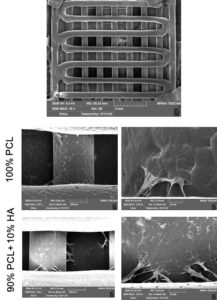Polycaprolactone is one of the biomaterials used in tissue engineering and regenerative medicine [1]. PCL have poor hydrophilicity and lack bioactivity; this issue can be partially solved by the incorporation of hydroxyapatite (HA) that allows PCL to improve mechanical and biological properties [2].
We 3D printed PCL and HA compound produced by Nadir s.r.l. for realizing 3D scaffold for bone TE. In particular, we set up a framework able to assess the printing performance and the sterility degree of 3D printed scaffolds. Moreover, we seeded 3D printed PCL-HA scaffolds using Human Adipose Stem Cells – hASC (in collaboration with Prof. Giulia Gastaldi of the University of Pavia and IRCCS Policlinico San Matteo Pavia) and we performed adhesion and proliferation tests.
The use of the 3D printer according to the proposed protocol allows it to obtain sterile finished scaffolds ready to be seeded with cells and used for bone TE applications. PCL-HA scaffold promotes adhesion of hASC (Fig 1).
References
[1] Fan D, Staufer U, Accardo A (2019) Bioengineering 6(4):113
[2] Zhang et al., Sci. Technol. Adv. Mater. 2016, 17(1), 136-148
February 4th, 2021


